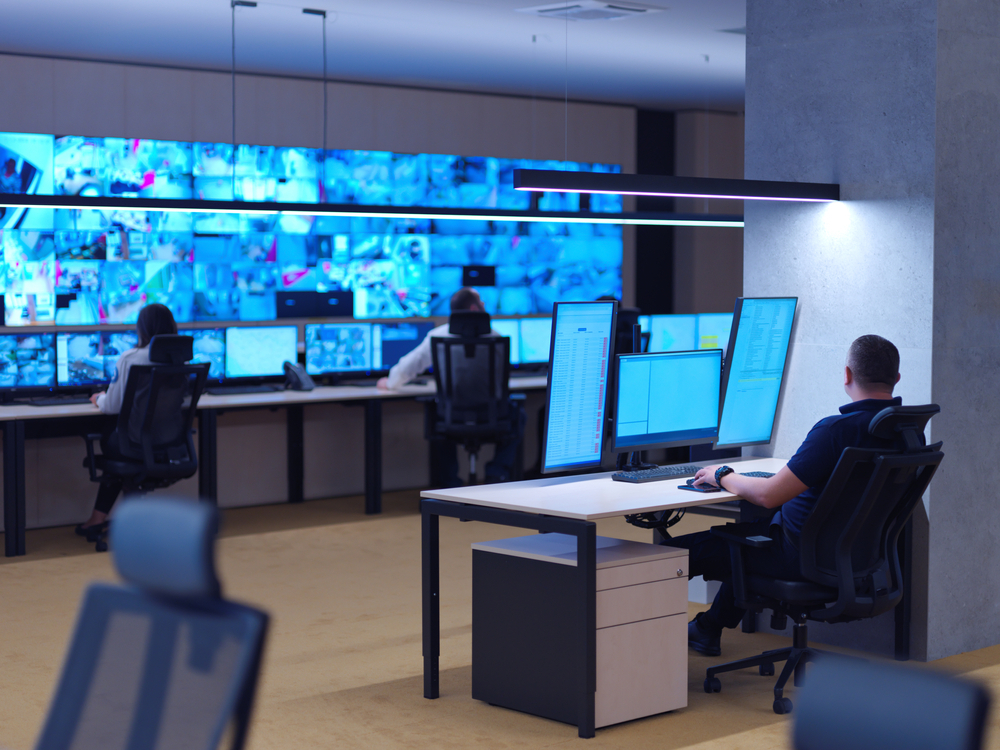Best Alternatives to Security Guards for Businesses in the USA

In the contemporary business landscape of the USA, ensuring robust security is a paramount concern for many organizations. While traditional security guards have been the go-to solution, technological advancements have paved the way for more efficient and cost-effective alternatives.
This article explores the best alternatives to security guards, focusing on how these modern solutions can safeguard businesses.
Table of Contents
1. Remote Live Video Monitoring
Live remote video monitoring is an advanced security solution where remote surveillance cameras installed at a business premises stream live footage to an off-site monitoring station. This approach serves as an alternative to traditional security guards by providing continuous, vigilant monitoring from trained professionals remotely.
Unlike static guards, this system offers extensive coverage, as cameras can monitor multiple areas simultaneously, including hard-to-reach or hidden spots. It enables real-time response to incidents, with professionals swiftly alerting local authorities or the business’s security team in case of any security breach.
This method merges the thoroughness of physical surveillance with the efficiency of modern technology, making it a more expansive, cost-effective, and versatile security option.
Benefits
Cost-Effectiveness
Traditional security measures often require multiple guards for complete coverage, especially for larger premises.
Remote monitoring reduces this need as one team can oversee multiple locations
simultaneously, significantly cutting down on manpower and associated costs like salaries, benefits, and training.
Comprehensive Coverage
Surveillance cameras, especially when equipped with modern features like wide-angle lenses, night vision, and motion detection, can survey areas far beyond the capability of a single guard.
Strategically placed cameras can cover blind spots (e.g., alleys, rooftops) and hard-to-reach areas, offering a 360-degree view of the premises.
Real-Time Response
The monitoring team can immediately identify security breaches as they happen, thanks to real-time video analysis.
Integration with other systems, like access control and alarm systems, enables a coordinated response, including triggering alarms or locking down certain areas.
Recorded Evidence
Digital recording of all surveillance footage provides a valuable resource for post-incident investigations.
This footage can be used for legal purposes, helping in the identification and prosecution of offenders.
How It Works – Technical Aspects
Camera Installation
High-definition cameras are installed at key points around the business premises. This includes entry points, sensitive areas, parking lots, and other critical locations.
Cameras are often IP-based, allowing for easy transmission of footage over the internet.
Live Streaming to Remote Center
The footage is transmitted, typically over a secure internet connection, to a remote monitoring center.
Advanced systems may employ encryption and other cybersecurity measures to protect the integrity and privacy of the video feeds.
Incident Response
The remote center is staffed by security professionals trained in identifying and responding to various security scenarios.
On detecting a threat or breach, they can immediately contact local law enforcement or the business’s internal security team.
Some systems allow for direct communication with the premises through intercoms or PA systems, enabling the monitoring team to address intruders or guide staff and visitors during an emergency.
2. Access Control Systems
Access Control Systems are advanced security solutions that manage and control access to a building or specific areas within it. These systems verify and grant entry only to authorized individuals, effectively regulating who can enter or exit the premises.
As an alternative to security guards, access control systems offer automated, consistent, and scalable security management. Unlike human guards, who may be prone to error or limited in monitoring capacity, these systems use technology like key cards, biometrics, or PIN codes to ensure only those with explicit permission can access the building.
This reduces the risk of unauthorized entry and provides a detailed log of all entries and exits, something that would be challenging and resource-intensive for a security guard to replicate. Additionally, these systems can be integrated with other security measures like alarms or surveillance cameras for a more comprehensive security approach.
Benefits:
Enhanced Security: Prevents unauthorized access.
Customizable Access: Different levels of access can be set for different areas.
Records Access History: Keeps a log of who enters and leaves, and when.
3. Alarm Systems
Alarm systems are sophisticated security tools designed to detect unauthorized access or unusual activities in a business environment. They serve as an effective alternative to traditional security guards by providing automated surveillance and immediate alerts. These systems typically use sensors and detectors to identify any breach, such as forced entry or motion in restricted areas.
Upon detecting a potential security threat, the alarm system promptly notifies business owners or designated security services, ensuring swift action can be taken. This immediate alert capability, combined with the system’s constant operational readiness, offers a level of vigilance and responsiveness that is challenging for human guards to match continuously, especially in larger or complex premises.
Benefits:
Deterrent to Intruders: The presence of an alarm system can deter potential burglaries or vandalism.
Immediate Alert: Ensures quick response to any security breaches.
Integration Capabilities: Can be integrated with other security systems for enhanced protection.
4. Artificial Intelligence (AI) and Machine Learning
AI and machine learning technologies in security systems represent a cutting-edge approach to preemptively identifying and mitigating potential threats. These technologies analyze vast amounts of data, learning from patterns and behaviors to predict and flag unusual activities that might indicate a security risk.
As an alternative to traditional security guards, AI and machine learning offer several advantages. First, their predictive capabilities allow for the identification of potential threats before they materialize, something human guards might not be able to do.
Secondly, these systems can monitor and analyze more data and at a faster rate than humans, covering a broader range of potential security breaches. This includes monitoring digital threats, which are beyond the scope of physical security personnel.
Benefits:
Proactive Security Measures: AI can analyze patterns and predict suspicious behaviors.
Efficient Monitoring: Reduces the workload on human monitors.
Constant Improvement: Machine learning algorithms continuously evolve, improving security over time.
5. Mobile Security Applications
Mobile security applications are digital tools that enable business owners and security teams to remotely monitor their premises using smartphones or other mobile devices. These apps provide real-time alerts and access to surveillance camera feeds, allowing for immediate oversight from any location.
As an alternative to traditional security guards, mobile security apps offer unparalleled flexibility and convenience, allowing users to stay informed and react promptly to any security concerns, even when off-site. This technology empowers business owners with constant vigilance and control over their security systems, surpassing the limited physical presence and scope of a human guard, especially in scenarios where immediate, informed response is crucial.
Benefits:
Remote Monitoring: Keep an eye on the business from anywhere.
Instant Notifications: Receive alerts for any suspicious activities.
Convenience: Easy to use and manage.
Conclusion
The alternatives to traditional security guards for businesses in the USA are diverse and technology-driven. From remote live video monitoring to AI-powered security systems, these solutions offer enhanced protection, cost-effectiveness, and adaptability. By embracing these modern security approaches, businesses can not only safeguard their premises more effectively but also leverage technology to stay ahead in an ever-evolving threat landscape.







